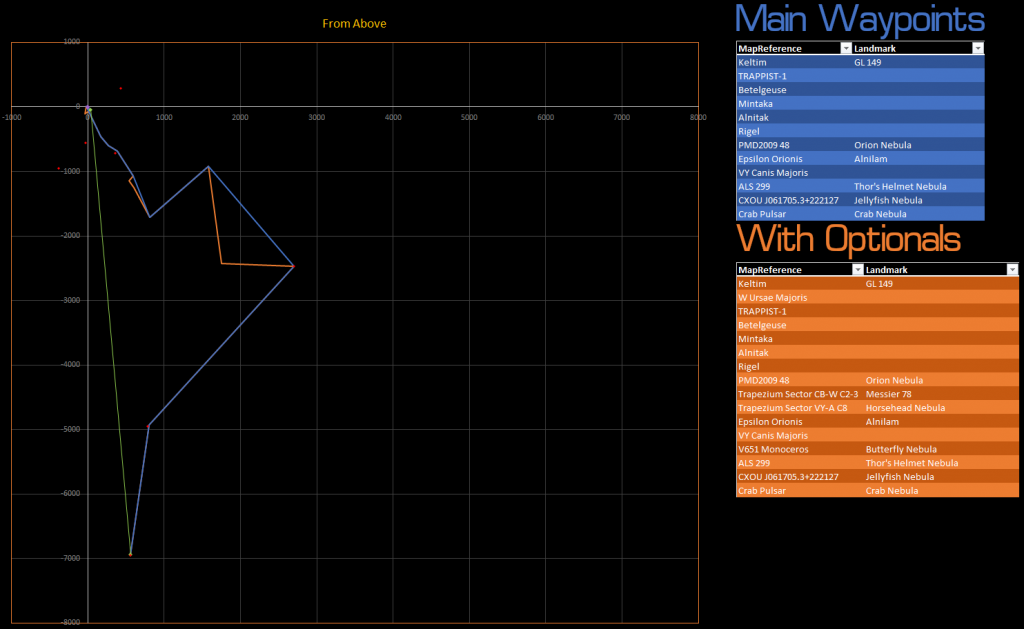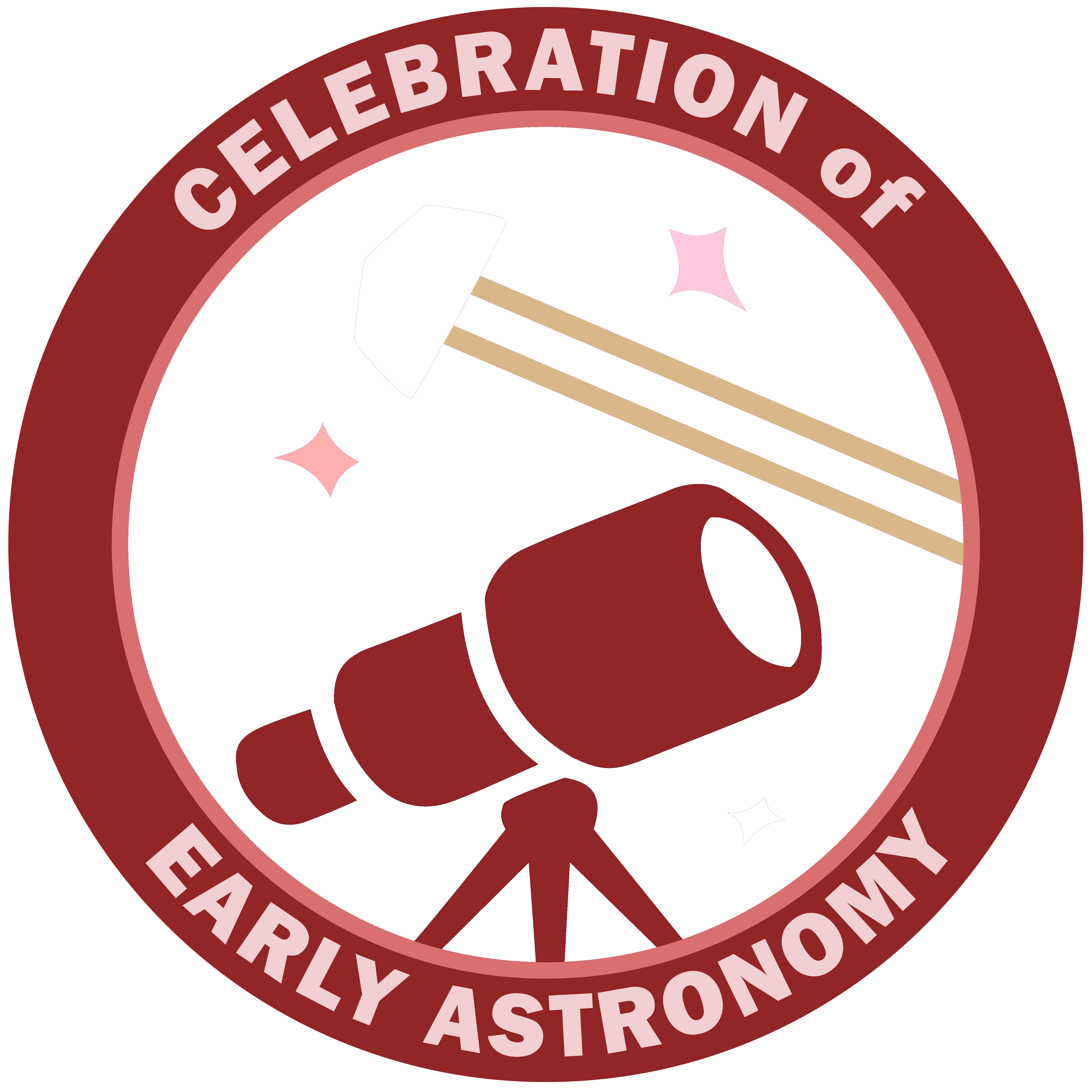Welcome to the first leg of our fourth expedition! In this leg we will be beginning to travel southward through the Orion Nebula and Barnard’s Loop regions and finishing up at the Crab Nebula.
Dates
Start Date: January 8, 2022
End Date: January 22, 2022
Distances
Basecamp Line: 6,949.14 Ly
Main Waypoints: 10,636.55 Ly
Optional Waypoints: 11,710.95 Ly
Map, (click for full size):

Basecamp: Crab Pulsar
Main Waypoints
- Map References quick reference list, more details below
- Keltim
- TRAPPIST-1
- Betelgeuse
- Mintaka
- Alnitak
- Rigel
- PMD2009 48
- Epsilon Orionis
- VY Canis Majoris
- ALS 299
- CXOU J061705.3+222127
- Crab Pulsar
Main Waypoints Details
- Map Reference: Keltim
- POI: GL 149
- Our faction’s home system, Keltim is also the real binary star pair known as GL 149, containing the stars CD-24 1826 and WT 1402.
- SIMBAD Link
- EDSM Link
- Map Reference: TRAPPIST-1
- The system where the real world and the Elite: Dangerous procedurally generated galaxy collided with each other. In early 2017 astronomers discovered seven approximately Earth-sized rocky exoplanets in orbit of Trappist-1. Three of which were within the habitable zone of this ultra-cool red dwarf star roughly 39.5 light years from Earth. Players of Elite: Dangerous quickly realized that there was a system in roughly the correct location called Core Sys Sector XU-P A5-0 at 42 Ly from Sol that happened to be a brown dwarf, not much colder than the red dwarf named Trappist-1 with seven terrestrial worlds around it. The system was officially tweaked to be a red dwarf and renamed to Trappist-1 for the 2.3 update.
- Map Reference: Betelgeuse
- Ninth brightest star in the night sky, and second brightest in the constellation Orion. Red supergiant of spectral type M1-2, one of the largest stars visible to the naked eye. This star is one of the shoulders of Orion.
- SIMBAD Link
- EDSM Link
- Map Reference: Mintaka
- The westernmost star of Orion’s Belt, a very recognizable landmark in the night sky.
- Map Reference: Alnitak
- The easternmost star of Orion’s Belt, a very recognizable landmark in the night sky.
There is a POI there named “Impressive Rings” on one of the other stars in the system. - SIMBAD Link
- The easternmost star of Orion’s Belt, a very recognizable landmark in the night sky.
- Map Reference: Rigel
- Rigel is the brightest star in the constellation Orion. It is expected to eventually end in supernova. Additionally it has two known companions Rigel B and Rigel C. However in-game it only seems to have Rigel B.
- Map Reference: PMD2009 48
- POI: Orion Nebula
- The Orion Nebula is a diffuse nebula situated south of Orion’s Belt in the constellation of Orion. It is one of the brightest nebulae in the night sky and is visible to the naked eye. It is also the closest region of massive star formation to our solar system. One of the most photographed objects in the night sky, and subject of intense study.
For those looking to dock to repair, refuel, and/or sell exploration data, there is also a starport located here in the PMD2009 48 system called the “Orion Nebula Tourist Center.”
Three SIMBAD Strasbourg links are relevant to this waypoint:- Orion Nebula: https://simbad.u-strasbg.fr/simbad/sim-id?Ident=Orion+Nebula
- Orion Nebula Cluster: https://simbad.u-strasbg.fr/simbad/sim-id?Ident=%40811295&Name=NAME%20Orion%20Nebula%20Cluster
- PMD2009 48: https://simbad.u-strasbg.fr/simbad/sim-id?Ident=PMD2009+48
- SIMBAD Link
- Map Reference: Epsilon Orionis
- POI: Alnilam
- To accompany Alnitak and Mintaka earlier in the leg, Alnilam is the middle star of Orion’s Belt.
- SIMBAD Link
- EDSM Link
- Map Reference: VY Canis Majoris
- The largest known star at the time of the in-game galaxy’s creation. There have been larger stars, such as UY Scuti discovered since, but they do not appear in the game. At this time this is the largest known star in the in-game galaxy. It is a red hypergiant located in the constellation of Canis Major. If it was placed in the center of our solar system, its surface would extend beyond the orbit of Jupiter at the least. There is still considerable variation regarding the true radius of VY Canis Majoris, some estimates even have it large enough to extend past the orbit of Saturn.
- Map Reference: ALS 299
- POI: Thor’s Helmet Nebula
- NGC 2359 (also known as Thor’s Helmet) is an emission nebula in the constellation Canis Major. The nebula is approximately 3,670 parsecs (11.96 thousand light years) away and 30 light-years in size. The central star is the Wolf-Rayet star WR7 (aka: ALS 299), an extremely hot star thought to be in a brief pre-supernova stage of evolution. It is similar in nature to the Bubble Nebula, but interactions with a nearby large molecular cloud are thought to have contributed to the more complex shape and curved bow-shock structure of Thor’s Helmet.
Multiple SIMBAD Links are relevant to this waypoint:- ALS 299: http://simbad.u-strasbg.fr/simbad/sim-id?Ident=ALS+299&submit=submit+id
- NGC 2359: https://simbad.u-strasbg.fr/simbad/sim-basic?Ident=NGC+2359
- SIMBAD Link
- Map Reference: CXOU J061705.3+222127
- POI: Jellyfish Nebula
- IC 443, also known as the Jellyfish Nebula is a supernova remnant, likely from CXOU J061705.3+222127
Multiple SIMBAD Links are relevant to this waypoint:- Jellyfish Nebula: http://simbad.u-strasbg.fr/simbad/sim-id?Ident=IC+443
- CXOU J061705.3+222127: https://simbad.u-strasbg.fr/simbad/sim-basic?Ident=CXOU+J061705.3%2B222127
- SIMBAD Link
- Map Reference: Crab Pulsar
- POI: Crab Nebula
- The Crab Pulsar (PSR B0531+21) is a relatively young neutron star. The star is the central star in the Crab Nebula, a remnant of the supernova SN 1054, which was widely observed on Earth in the year 1054.[4][5][6] Discovered in 1968, the pulsar was the first to be connected with a supernova remnant.
Multiple SIMBAD Links are relevant to this waypoint:- Crab Pulsar: https://simbad.u-strasbg.fr/simbad/sim-basic?Ident=Crab+Pulsar
- Crab Nebula: https://simbad.u-strasbg.fr/simbad/sim-basic?Ident=Crab+Nebula
- SIMBAD Link
Optional Waypoints
- Map References quick reference list, more details below
- Keltim
- W Ursae Majoris
- TRAPPIST-1
- Betelgeuse
- Mintaka
- Alnitak
- Rigel
- PMD2009 48
- Trapezium Sector CB-W C2-3
- Trapezium Sector VY-A C8
- Epsilon Orionis
- VY Canis Majoris
- V651 Monoceros
- ALS 299
- CXOU J061705.3+222127
- Crab Pulsar
Optional Waypoints Details
- Map Reference: W Ursae Majoris
- W Ursae Majoris is a binary star near to our departure point. It is too faint to see with the naked eye, but it can be viewed with the assistance of a telescope. (There is an unlockable EDSM badge for visiting here)
- Map Reference: Trapezium Sector CB-W C2-3
- POI: Messier 78
- Messier 78 is a nebula in the Barnard’s Loop area, blue and black in colouration. It is a reflection Nebula discovered by Pierre Méchain in 1780 and then included by Charles Messier in his catalog that members of are now referred to as Messier objects. This object was also featured in the 1960s era Japanese anime Ultraman as the location of “The Land of Light” that acted as the homeworld of the Ultramen.
- SIMBAD Link
- EDSM Link
- Map Reference: Trapezium Sector VY-A C8
- Also known as Barnard 33, the Horsehead Nebula is a dark nebula in the constellation Orion, located just south of Alnitak, the easternmost star of Orion’s Belt, and is part of the Orion Molecular Cloud Complex. It appears in the southern region of the LDN 1630 dust cloud.
Trapezium Sector VY-A C5 is the closest system with the correct viewing angle of the Horsehead Nebula that can be reached due to the Horsehead Dark Region being permit locked.
Multiple SIMBAD Links are relevant to this waypoint:- Horsehead Nebula: https://simbad.u-strasbg.fr/simbad/sim-basic?Ident=Horsehead+Nebula
- LDN 1630 Dust Cloud: https://simbad.u-strasbg.fr/simbad/sim-basic?Ident=LDN+1630
- SIMBAD Link
- Also known as Barnard 33, the Horsehead Nebula is a dark nebula in the constellation Orion, located just south of Alnitak, the easternmost star of Orion’s Belt, and is part of the Orion Molecular Cloud Complex. It appears in the southern region of the LDN 1630 dust cloud.
- Map Reference: V651 Monoceros
- POI: Butterfly Nebula
- The bright clusters and nebulae of planet Earth’s night sky are often named for flowers or insects. Though its wingspan covers over 3 light-years, NGC 6302 is no exception. With an estimated surface temperature of about 250,000 degrees C, the dying central star of this particular planetary nebula has become exceptionally hot, shining brightly in ultraviolet light but hidden from direct view by a dense torus of dust.
Text credit with photograph: https://www.nasa.gov/multimedia/imagegallery/image_feature_2526.html
Multiple SIMBAD Strasbourg links are relevant to this waypoint:- Butterfly Nebula: https://simbad.u-strasbg.fr/simbad/sim-basic?Ident=Butterfly+Nebula
- V651 Monoceros: https://simbad.u-strasbg.fr/simbad/sim-basic?Ident=V651+Monoceros
- SIMBAD Link
